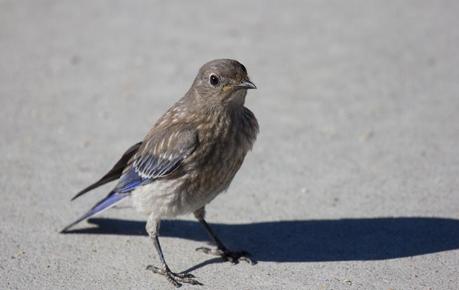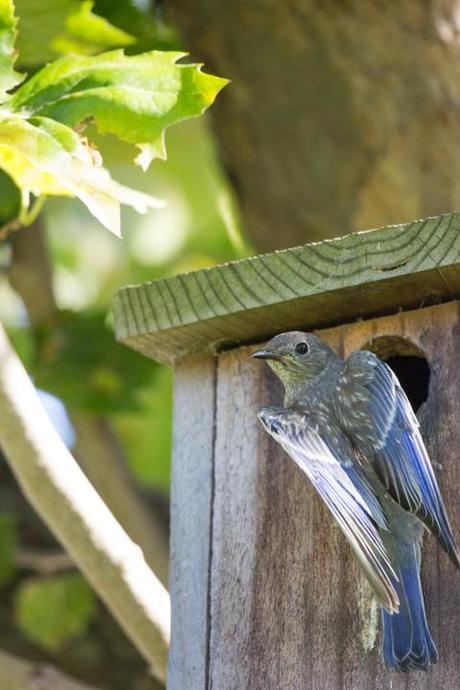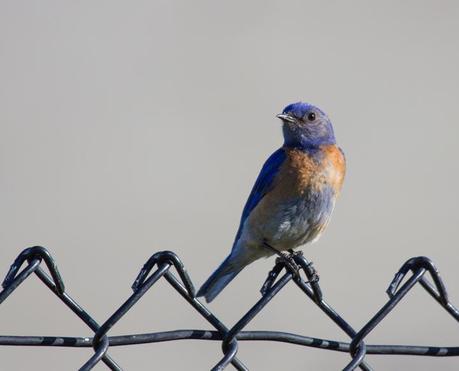Sialia mexicana
 This young Western Bluebird helps his parents by feeding insects to his baby siblings. Photo: Elaine Miller Bond.
This young Western Bluebird helps his parents by feeding insects to his baby siblings. Photo: Elaine Miller Bond.
The Western Bluebird (Sialia mexicana) is a small thrush, approximately 5.9″ to 7.1″ in length. This bluebird is distinct from the Eastern and Mountain Bluebirds because of the Western’s blue-colored (males) and gray-colored throats (females).
Western Bluebirds nest in cavities or in nest boxes, competing with Tree Swallows, House Sparrows, and European Starlings for natural nesting locations. House sparrows, in groups or alone, often attack Western Bluebirds for their nests.
These birds mainly eat berries and insects, and are very helpful with pest control. They wait on a perch and fly down to catch insects, sometimes catching them in midair.
Western Bluebirds’ eggs are oval shape, with a smooth and glossy shell, and pale blue to bluish white and sometimes white in color. Babies remain in a nest about 19–22 days before fledging. In a good year, the parents can rear two brood, with 4 to 6 eggs per clutch.
According to genetic studies, 45% of Western Bluebirds’ nests carried young that were not offspring of the male partner. In addition, adolescent Western Bluebirds — almost always sons — will help their parents raise a new brood.
The account below is taken from an article, with pictures, by Elaine Miller Bond on just such a young male “helper” Western Bluebird, part of a family of western bluebirds living and nesting in an urban park in Northern California.

The young helper male Western Bluebird in the picture above was a fledgling of a few weeks old. For weeks, he would undertake intensive hunting forays across the park, even “mugging” a house sparrow and competing with his parents, beak-to-beak, for insects and worms — food he delivered to his younger brother and two sisters in the nest. He continued to feed his younger siblings even after they had fledged and taken up residence in the trees.

This behavior — a form of “helping” — is rare. According to Professor Janis Dickinson, Director of Citizen Science at The Cornell Lab of Ornithology, an average of 7% of Western Bluebird pairs receive extra help in tending their nests. Worldwide, only 3% of bird species are “cooperative breeders.”
One theory is that sons tend to the younger chicks as a form of “rent” — of paying back their hard-working parents for living at home and pecking food in their territory. Most sons spend their first winters with Mom and Dad. Daughters disperse by fall.


Western bluebirds help as adults, too, but they are exclusively male. Their mates may have died, or their nests may have failed. So they turn their efforts to help their family members — their parents, brother and sister-in-law, maybe grandpa and his mate — providing extra meals to their chicks. If these chicks grow faster and leave home sooner, Mom and Dad might get a chance at a second brood.
What the young “helper” males promote is what biologists call “inclusive fitness” — the combined fitness achieved by surviving and producing one’s own offspring, plus the fitness one gets by increasing the number of offspring that relatives produce beyond what they would achieve without your help.

Western bluebirds switch their diets, from bugs in summer to berries in winter. Small flocks of bluebirds have been spotted gorging on crops of winter berries. They seem to take a particular liking to catony aster berries, pyracantha berries, Himalayan blackberries, and also blueberries.
How to help western bluebirds:
- Keep pet cats (predators) indoors.
- Refrain from using pesticides; they kill the crawlies that bluebirds eat.
- Protect old-growth oak trees, the natural habitat and feeding grounds for Western Bluebirds.
Click here for more pics by Elaine Miller Bond.
~Eowyn

